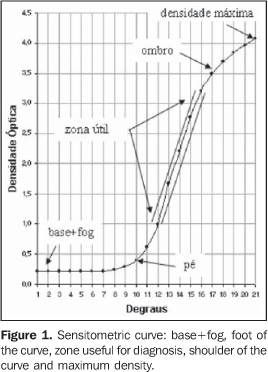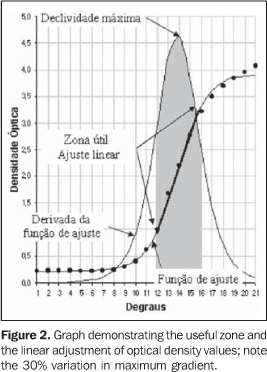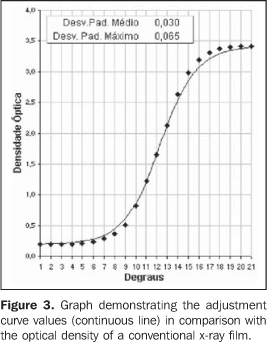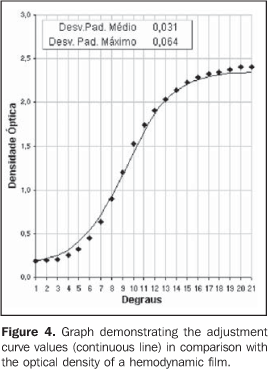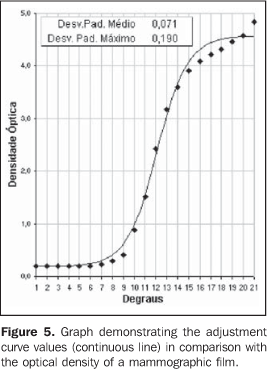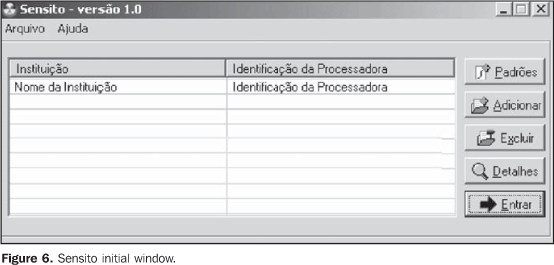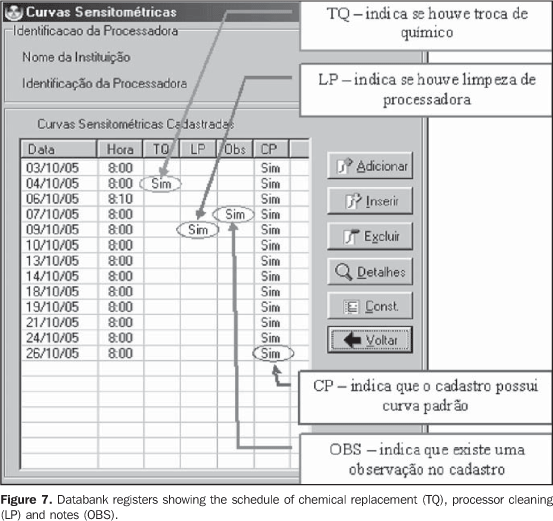Radiologia Brasileira - Publicação Científica Oficial do Colégio Brasileiro de Radiologia
AMB - Associação Médica Brasileira CNA - Comissão Nacional de Acreditação
 Vol. 40 nº 2 - Mar. / Apr. of 2007
Vol. 40 nº 2 - Mar. / Apr. of 2007
|
ORIGINAL ARTICLE
|
|
Development of a software for evaluation and control of sensitometric characteristics in automatic films processing |
|
|
Autho(rs): Vagner Ferreira Cassola, Gabriela Hoff |
|
|
Keywords: Automatic processor, Sensitometric curve, Sensitometry |
|
|
Abstract:
IMaster Degree Student at Program of Post-graduation in Energy and Nuclear Technologies – Departamento de Energia Nuclear da Universidade Federal de Pernambuco (UFPE), Recife, PE, Brazil, Collaborator for Grupo de Experimentação e Simulação Computacional em Física Médica (GESiC), Porto Alegre, RS, Brazil
INTRODUCTION Small changes in the automatic films processing may result ina significant loss or degradation in the quality of informationrecorded on radiographic images. Inadequate processing affectsthe image quality, demanding higher radiation dose for obtaininga satisfactory radiological image(1).Therefore, quality control is essential for guaranteeing theaccuracy of x-ray-based diagnoses. For this purpose, sensitometryis one of the most effective methods for monitoring changes inconditions of the automatic imagesprocessing(2–4). The Order (Portaria) No. 453/98 of Secretaria deVigilância Sanitária do Ministério daSaúde (Brazilian Ministry of Health National SanitaryVigilance Agency)(5) establishes that in aquality assurance program, a sensitometric test must be performedin the images processing system, at least weekly for conventionalradiology, and daily for mammography. Considering thatsensitometry is a way to indicate corrective measures to avoiddeterioration of radiological images, it would be advisable toperform this test on a daily basis, preferably early in the workroutine, in order to avoid that images are affected bymisfunctioning of the images processing system. The evaluation of processing conditions by means ofsensitometric curves analysis may be manually performed, althoughthis method is time-demanding and may lead to miscalculations anddiscrepancies when different people analyze a same curve.Generally, the analysis is performed with the help of softwaresprovided by the radiological films suppliers themselves. Thisconstitutes a limiting factor, since different softwares analyzesensitometric curves in a different way, that is to say,depending on the software utilized for a same sensitometric curveone may obtain a different value for characteristics such ascontrast and film speed. The present study presents Sensito, a software tool forevaluation and management of sensitometric curvescharacteristics. A generalized way of analysis was adopted in thedevelopment of this software, therefore sensitometric curves canbe evaluated by the same software in different modalities ofRadiology, with no need of user-dependent adjustments, and withno systematic deviation in the evaluated sensitometric parametersand variations. If previously registered, non-conformities areautomatically detected as the sensitometric curve graph isgenerated. The software allows the creation and maintenance of adatabase including sensitometric curves from different processorsin a same institution, easily generating gamma curves of aregister and constant charts of the evaluated sensitometriccharacteristics, which play an essential role in the imagesquality control(6).
MATERIALS AND METHODS The development of the software for sensitometric analysis demands the knowledge on the definitions of some specific characteristics of the sensitometric curve, or H&D curve(4) (Hurter & Driffield), associating the film blackening degree, or optical density (OD) with the film exposure. Based on the sensitometric curve, it is possible to evaluate the contrast, latitude, gradient, film speed, and base+fog values. The foot of the curve corresponds to low density regions, and the shoulder of the curve corresponds to high density regions. The linear region of the curve corresponds to densities useful for diagnosis(4), and hereafter will be denominated "useful zone", as shown on Figure 1.
The determination of the sensitometric curve characteristicsundergoes a critical stage: the definition of the useful area ofthe film, since there is no step or specific density defining thebeginning or end of this area, as it happens in some softwaretools or data collection protocols. This zone should only becharacterized by the region where the sensitometric curvepresents a linear behavior(4). The center ofthis region is approximately the point of involution in thecurve. Therefore, if a software is able to automatically generatean equation for to sensitometric data, the useful zone may bedefined by means of a percentage variation in the correspondentmaximum gradient of the involution point in the equation. Basedon sensitometric data, adjustments were determined forrepresenting the behavior of the optical densities data asfunction of the logarithm of relative exposure, represented bythe hyperbolic tangent (tanh) function. Parameters wereadded to this function, generating the following equation whosevalues, on average, are compatible with the optical densitiesdata of the sensitometric curves: DO(x) = M . [tanh((x – PM) . PASSO) + ZF] + BF where: x represents the logarithm of relative exposure;PM is the logarithm of relative exposure concerning thesensitometric curve mean point; BF is base+fog, bydefinition, the optical density of the first step of the curve;PASSO represents the equation growth swiftness; ZFcorresponds to zero to start off with (zero factor principle);M represents the equation height. All the parameters areautomatically determined according to the sensitometric dataobtained. The Figure 2 demonstrates the approximation of actual sensitometric data of a sensitometric curve with those generated by the adjustment curve. The data demonstrated that a 30% variation in the gradient corresponding to the involution point allows the definition of a region where a straight line can be drawn, with a 99% linear relationship between this line and sensitometric data. The ratio was obtained through the square of the Pearson product-moment correlation. The straight-line equation is obtained by means of a linear adjustment of the optical densities in this region, as follows: DO(x) = G . x + A
where: x represents the logarithm of relative exposure;G is the curve gradient; A is a constant concerningthe straight-line intersection point with the horizontalaxis. Based the straight-line equation G gradient, the usefulzone, the sensitometric parameter of the gradient is estimated.The film latitude is obtained by the variation of the logarithmof relative exposure concerning the beginning and end of theuseful zone, determined by the 30% variation in the maximumgradient. The contrast is a result of the variation of opticaldensities corresponding to the logarithms of relative exposure,of the steps utilized for determining the latitude which areestimated by means of the straight-line equation. The speed,corresponding to the reverse logarithm of relative exposureconcerning the optical density 1 above the base+fog value, may beestimated by utilizing the linear adjustment as per theequation:
RESULTS The adjustment equation was tested for conventional x-ray, hemodynamics and mammography curves, as shown on Figures 3, 4 and 5. The values generated by the equation demonstrated a great similarity to the values of optical densities of conventional x-ray and hemodynamic films evaluated, with maximum deviation among density values lower than 7%. For the mammography film curve, as shown on Figure 5, there was a difference in values corresponding to the curve foot and shoulder, but, as it can be observed, the corresponding steps are similar in both curves, demonstrating a similar behavior between curve and equation. This reflects the points asymmetry on the curve describing the film behavior. However, the adjustment equation if utilized just for estimating the involution point of the curve, i.e., of the mean point in the useful zone of the curve and of the limits corresponding to the beginning and end of this zone. Therefore, the adjustment equation should present a similar behavior, mainly in the center of the curve to allow a more accurate estimation of the useful zone of the film by means of the gradient variation. This similarity in the behavior in the center of the curve was observed in all of the films evaluated.
Based on the described adjustment equation, a software toolfor analysis of sensitometric curves was developed in C++language, utilizing the Borland C++ Builder 6 compiler, and theMicrosoft Excel application. This software denominated Sensito,besides analyzing the sensitometric curves characteristics,allows the generation of a databank to facilitate thesensitometric management of such characteristics, easilygenerating constant graphs. The beta version of this software was tested by the Radiology Unit at Hospital de Clínicas de Porto Alegre, and modifications and adjustments were made to generate the first version of the software (Figure 6). Upon visualization of a curve in the processor data bank, the software indicates the occurrence of chemical replacement, processor cleaning, existence of any note linked to the register, or if the curve follows a standard (Figure 7). This information facilitates the sensitometric control; anomalies detected by the sensitometric curve in the films developing may be better understood with this type of analysis.
The sensitometric curves graphs, together with the standard curve, if available, are visualized on an Excel worksheet generated by the software itself. The space below the graph shows the base+fog value, film speed, contrast and gradient for both the present and standard curves. The present and standard curves deviations are shown on the column "Deviations", beside the column "Thresholds" (acceptance limit). If any of the values present a deviation higher than the acceptance limit, the note "Out-of-Limit" is shown, as it can be seen on Figure 8.
Concomitantly with the Excel graphs of sensitometric curves, agamma curve concerning the visualized register is generated. Thegamma curve may be a way of determining the ideal processingconditions, and, on the other hand, it may be useful fordetecting processing problems(7). Together withthe graph, the highest contrast found and the value of the areabelow the curve are displayed. The constant graphs may be automatically generated from a meanvalue of a period defined by the user or from a standard curve. Aconstant graph demonstrates na interest-value (the speed rate,for example) as a function of time(6). Thebase+ fog, film speed, contrast and gradient data are orderly displayedon an Excel worksheet, together with the respective constantgraphs and acceptance limits, based on the mean interval valuesor the processor standard curve. The acceptance limits may bedefined by the users. The Sensito software is available for free download at: http://www.pucrs.br/fisica/fimebi/gesic/sensito.htm
DISCUSSION Problems associated with radiological films processing stillexist(8) and should be highlighted. The Sensitosoftware was developed as an important tool for sensitometriccontrol, with a quite friendly interface, and a manual includinga step-by-step tutorial. More than 100 curves of films anddifferent processors were tested aiming at validating the methodfor generation of sensitometric curves. The mean deviationbetween values of sensitometric curves and those resulting fromthe equation was lower than 10%. This result demonstrates thatthe adjustment equation is appropriate for the data to beanalyzed. So this software can be utilized both for analysis oflow-contrast films (in hemodynamics, for example) andhigh-contrast films (in mammography, for example). Acknowledgements The authors thank the physicist and Master Degree in EducationAlexandre Bacelar, and the physicist Fernanda Ramos de Oliveira,of Hospital de Clínicas in Porto Alegre, RS, Brazil.
REFERENCES 1. Suleiman OH, Conway BJ, Rueter FG, Slayton RJ. Automatic film processing: analysis of 9 years of observations. Radiology 1992;185:25–28. [ ] 2. Kofler JM, Gray JE. Sensitometric responses of selected medical radiographic films. Radiology 1991;181:879–883. [ ] 3. Haus AG. Mammography imaging physics: screen-film processing and viewing condition considerations. RSNA Categorical Course in Breast Imaging 1999;59–77. [ ] 4. Magalhães LAG, Azevedo ACP, Carvalho ACP. A importância do controle de qualidade de processadoras automáticas. Radiol Bras 2002;35:357–363. [ ] 5. Brasil. Secretaria de Vigilância Sanitária. Ministério da Saúde. Regulamento técnico. Diretrizes de proteção radiológica em radiodiagnóstico médico e odontológico. Portaria nº 453. Diário Oficial da União:Brasília , 2/6/98. [ ] 6. Gray JE. Technical aspects of screen-film radiography, film processing, and quality control. RadioGraphics 1997;17:177–187. [ ] 7. Hendrick RE, Berns EA. Optimizing mammographic techniques. RSNA Categorical Course in Breast Imaging 1999;79–89. [ ] 8. Magalhães LAG, Oliveira SR, Silva MO, Azevedo ACP, Carvalho ACP. Avaliação da velocidade de processamento de processadoras automáticas utilizando o método "STEP test". Radiol Bras 2004;37:185–186. [ ]
Received April 12, 2006.
* Study developed at Pontifícia Universidade Católica do Rio Grande do Sul (PUCRS), Grupo de Experimentação e Simulação Computacional em Física Médica (GESiC), Porto Alegre, RS, Brazil. |
|
Av. Paulista, 37 - 7° andar - Conj. 71 - CEP 01311-902 - São Paulo - SP - Brazil - Phone: (11) 3372-4544 - Fax: (11) 3372-4554
